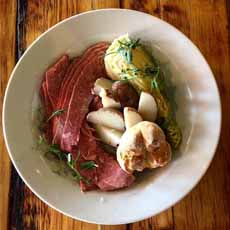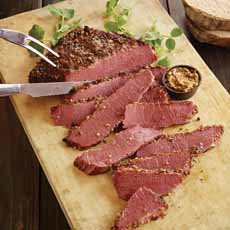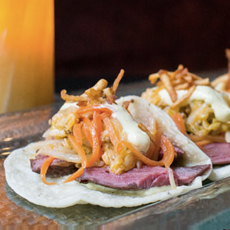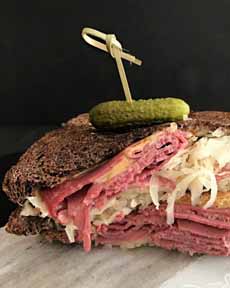ST. PATRICK’S DAY: Corned Beef Recipes
|
March 17th, St. Patrick’s Day, is National Corned Beef & Cabbage Day. Corned beef and cabbage is a St. Patrick’s Day standard. But wait: The dish isn’t from Ireland, but from New York City’s Lower East Side. Although the exact beginnings of corned beef are lost to history, it most likely was created when people began preserving meat through salt-curing—an ancient practice. Corning refers to curing or pickling the meat in a seasoned brine. The word refers to the “corns” or grains of rock salt (today, kosher salt is used) that are mixed with water to make the brine. (Curing meat and fish with salt was an ancient practice in numerous cultures.) Typically, brisket is used to make corned beef. Brisket is a cut of meat from the breast or lower chest of the cow (photo #2) The dish has many regional variations and seasonings. Smoking a corned beef and adding extra spices produces pastrami. Historically, cattle in Ireland were not used for meat but for dairy products. Pork, affordable, was the predominant meat. It wasn’t until England’s 16th century conquering of Ireland that the cow became a meat animal—but its availability was limited to the Irish population because of the cost. Then came the massive migration of Irish, Jewish, and other populations from Europe to the U.S. Corned beef was a staple in middle-European Jewish cuisine. Irish immigrants learned about corned beef from their Jewish neighbors on New York’s Lower East Side. They adopted it as a cheaper alternative to imported Irish bacon. (Irish bacon is a lean, smoked pork loin similar to Canadian bacon. Here are the different types of bacon.) In the U.S., pork was much more expensive than the American staple meat, beef. Brisket, which required several hours of cooking to tenderize, was an affordable cut. Bacon and cabbage is a popular Irish dish, so the marriage was made: Irish Americans substituted corned beef for the bacon, and Corned Beef & Cabbage was born (photo #3). |
|
|
|
CHECK OUT WHAT’S HAPPENING ON OUR HOME PAGE, THENIBBLE.COM.
|
||






